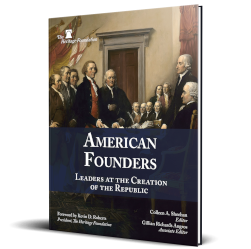Nonpartisan agreement exists among policymakers, educators, and parents that more K–12 students should be proficient in civics before they graduate high school. Researchers at the Brookings Institution write that “civic learning is on the margins of young people’s school experience.”REF The Sandra Day O’Connor Institute, which researches and advocates civics instruction in K–12 schools, bemoans the condition of civics teaching today in a report titled, “When and Why Did America Stop Teaching Civics?,” saying, “American schools once prioritized civics instruction and no longer do.”REF Similar sentiments have been expressed recently by right-of-center publications, such as National Review, and groups that advocate traditional civics instruction, such as the Jack Miller Center.REF
Civics instruction in K–12 schools today has two deficiencies: First, civics is simply not taught in enough classrooms nationwide. In a survey conducted by the U.S. Department of Education, just 49 percent of eighth-graders reported taking a class primarily focused on civics or the U.S. government in 2022, while 32 percent took a class with some emphasis on the subject.REF Meanwhile, 8 percent said they had no such course. Students who took a course dedicated to civics or that focused heavily on the subject outperformed their peers on national comparisons of civics knowledge. As this Backgrounder demonstrates, some state lawmakers have not adopted any civics requirements for K–12 schools.
Second, the topics that educators include in civics have changed drastically. Instead of learning why virtue underpins a representative society, students are to “engage in civic actions” and “flex their civic muscles,” according to one set of civics material from the Los Angeles Unified School District, the nation’s second-largest school district.REF Students are inundated with lessons about “intersectionality,” a principle idea from the radical Marxist philosophy of critical race theory, and identity politics, in civics and elsewhere in the school curriculum.
A century ago, civics education was inseparable from the teaching of personal responsibility and virtues in K–12 schools. These life skills were considered vital for young people to learn before they entered adulthood. In a textbook published in 1928 on civics and training students for the workplace, the author writes that “this text strives to develop character in the student” (emphasis in the original).REF Furthermore, the author explains that educators should “produce a citizen who is an effective worker, and a worker who is an effective citizen.” Notably, this text is representative of many other civics textbooks of this period when the author states that “[i]nformation, energy, skill, wealth—none of these can benefit the community unless its boys and girls are governed by moral purpose.”REF
In a civics textbook by Samuel Eagle Forman, first published in 1912, the author writes: “To equip a lad with a knowledge of the working of governments and the rights of citizens, without equipping him with a conscience that will constrain him to practice the virtues of citizenship, may be to prepare him for a more successful career as a public rogue.”REF
Forman stresses that the teacher’s practice of virtue is essential: “In the teaching of civics the best must always come from the teacher. His citizenship, his life, will teach more than can be learned from a book.”REF
Wall Street Journal columnist Peggy Noonan cited the Manual of Patriotism: For Use in the Public Schools of New York, a book published in 1900 for New York students after the state legislature adopted a law requiring public schools to display the American flag and “encourage patriotic exercises.”REF Here, too, the Manual’s author stresses virtues—courage, temperance, justice, to name a few: “I have been inspired by the belief that to preserve our free institutions in all their old-time vigor and prestige, our system of public education must more and more lay stress on those civic virtues which develop and ennoble true and patriotic citizenship.”REF
In the early 20th century, educators considered civics instruction a process of training young people to live honestly and demonstrate decency. Textbooks included information about the American form of government and the history of how the country’s political institutions were formed, but civics instruction would return to the question of personal virtue and character. “Indeed, it is a duty we owe not simply to our selves [sic], our family, our friends and to our country, but to our Creator who gave it, that we make [our life] the very best life of which it is capable,” reads a civics textbook written for Wisconsin schools in 1921.REF Students should learn “self control and self direction.”REF
A century later, civics instruction now includes indoctrination about “gender identity” and eschews “rote memorization of names, dates, and processes”—which means that fewer and fewer students know any names, dates, and processes concerning their own government.REF As part of the “action civics” movement, students protest the use of plastic bags at grocery stores, participate in marches to tighten gun laws, and walk out of school to show disagreement with everything from the use of standardized testing to the results of the 2016 presidential election.REF As part of a civics assignment, a Michigan student wanted to make crayons more “equitable” and raised money to create race-based coloring materials to match different skin tones.REF
Civics instruction has become an exercise in protest and teaching students to be activists—without much factual information. Furthermore, any lessons on character formation that still exist have abandoned traditional virtues, such as self-control and justice, in favor of resentment and the self-loathing characteristics of racial favoritism.
State policymakers should revise academic standards on civics, social studies, and history so that K–12 instruction stresses the virtuous ideals embedded in the nation’s Founding documents. Students should learn that responsibility and virtue are necessary for the success of representative government. More fundamentally, however, teachers and so-called social justice activists should not use civics instruction to train students to be activists for political causes during school hours.
This Backgrounder provides data on the poor student outcomes on civics assessments. It lists the civics standards that are applied in each state, and explains that some state lawmakers, such as officials in Florida and Louisiana, have updated their standards to create rigorous, fact-based instructional materials for students. Finally, the Backgrounder includes policy recommendations for state lawmakers so that they can reject attempts to make civics instruction an exercise in training students to be protestors and focus on preparing students to understand their system of government and become participating members in civil society.
Civics Assessments
Few civics tests allow policymakers and researchers to measure student progress in civics and make meaningful comparisons between K–12 students. The two most reliable assessments are the civics portion of the National Assessment of Educational Progress (NAEP) and the U.S. Citizenship and Immigration Services (USCIS) test for immigrants.
The NAEP Civics Exam. The NAEP civics exam evaluates the civics knowledge of a representative sample of students in fourth, eighth, and 12th grades. It was administered in 1998 and has been administered every four years since 2006 but has only been given to eighth-graders since 2014. Scores have changed little since the first time the test was administered in 1998. Average scores rose slightly between then and 2014 but have since returned to the same level as in the first test administration. Approximately one in three students has scored below the “basic” level since the test was first given.REF Moreover, only 22 percent of eighth-graders scored at or above the proficient level, reflecting a solid command of academic performance and civics competence. That figure dropped to 10 percent and 12 percent proficient for black and Hispanic eighth-grade students, respectively. Private school students have outperformed public school students since the first assessment was first administered in 1998.
In 2022, more students (23 percent) reported in the NAEP survey following the civics exam that they had “low confidence in their civics knowledge and skills” than in 2018 (26 percent).REF
The Naturalization Test. Immigrants seeking citizenship in the U.S. must attain a passing score on the USCIS test.REF The test requires test takers to be able to read aloud three sentences in English and correctly write three sentences in English in addition to answering six questions correctly on a 10-question assessment.
These standards may seem basic, but the Institute for Citizens & Scholars, an education consulting organization, found that only one of three Americans could pass the multiple choice section of the test.REF The survey found that just 13 percent of respondents could say when the U.S. Constitution had been ratified and 60 percent did not know who America’s allies and opponents were in World War II.REF Remarkably, nearly 96 percent of immigrants attempting to become U.S. citizens pass the test, with 88 percent passing the test on the first try.REF
State Civics Standards. Policymakers in 40 states and the District of Columbia have adopted provisions that require high school students to take a civics, history, social studies, or American government course, or an end-of-course (EOC) examination, or both. The requirements differ from state to state (see Table 1). Some states require students to complete a course and take a test, but many do not require students to earn a passing score on the test as a condition of earning a diploma. Other state standards require students to take all or a portion of the USCIS test.
Alabama’s standards, for example, are straightforward: Students must take a course in American government or civics and pass the USCIS citizenship test to graduate high school. In Arizona, students must take a course and score above 70 percent on the citizenship test. Arizona lawmakers were the first to require that students take the citizenship test and earn a certain score as a condition of graduating high school.REF
The provisions in other states are less rigorous. California students are only required to take social studies, though the academic standards for this course include a section on American democracy. In Connecticut and Ohio, students must complete and pass a course in civics, but they are not required to earn a passing score on a civics exam to graduate. In fact, Connecticut does not require students to take a civics exam at all.
Florida and Louisiana serve as models for legislators and school boards nationwide because policymakers in these states have adopted course requirements, test requirements, and stipulations that students pass final tests. The next section describes the civics standards and requirements in these states.
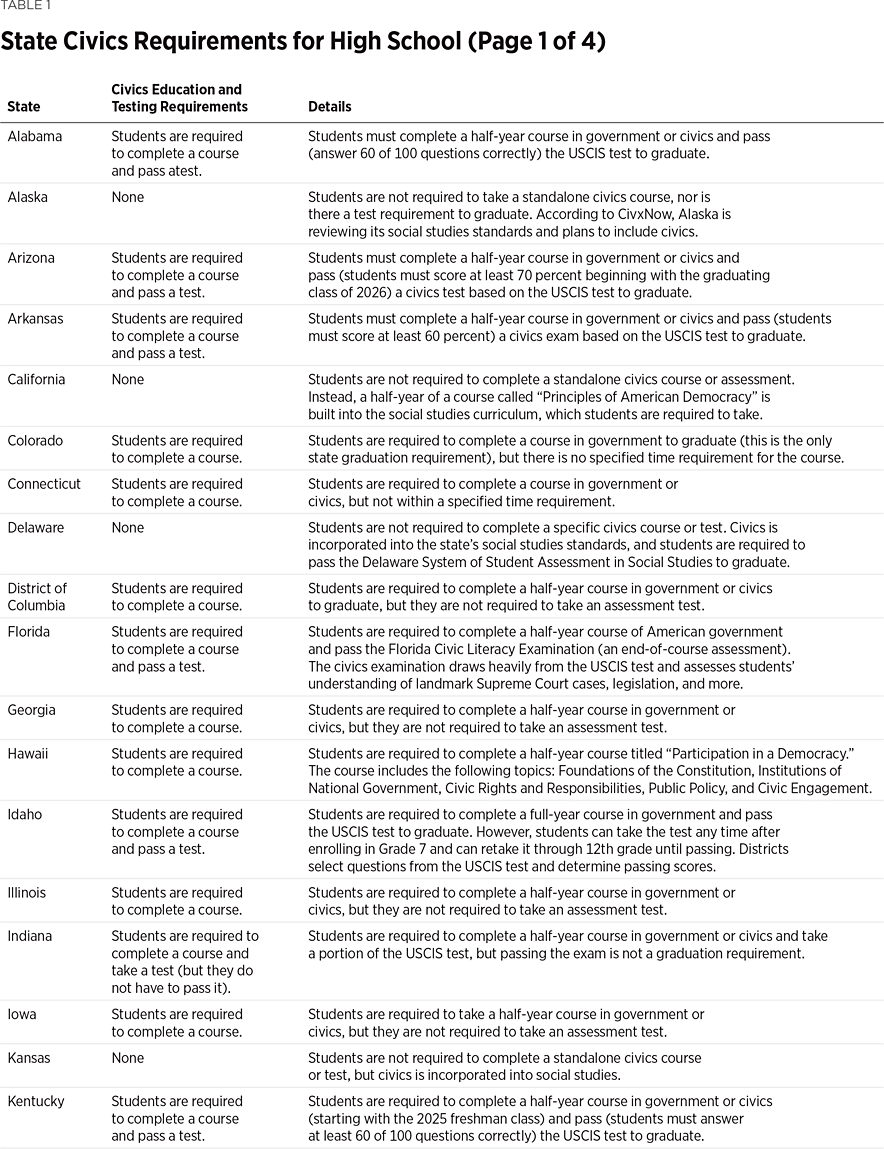
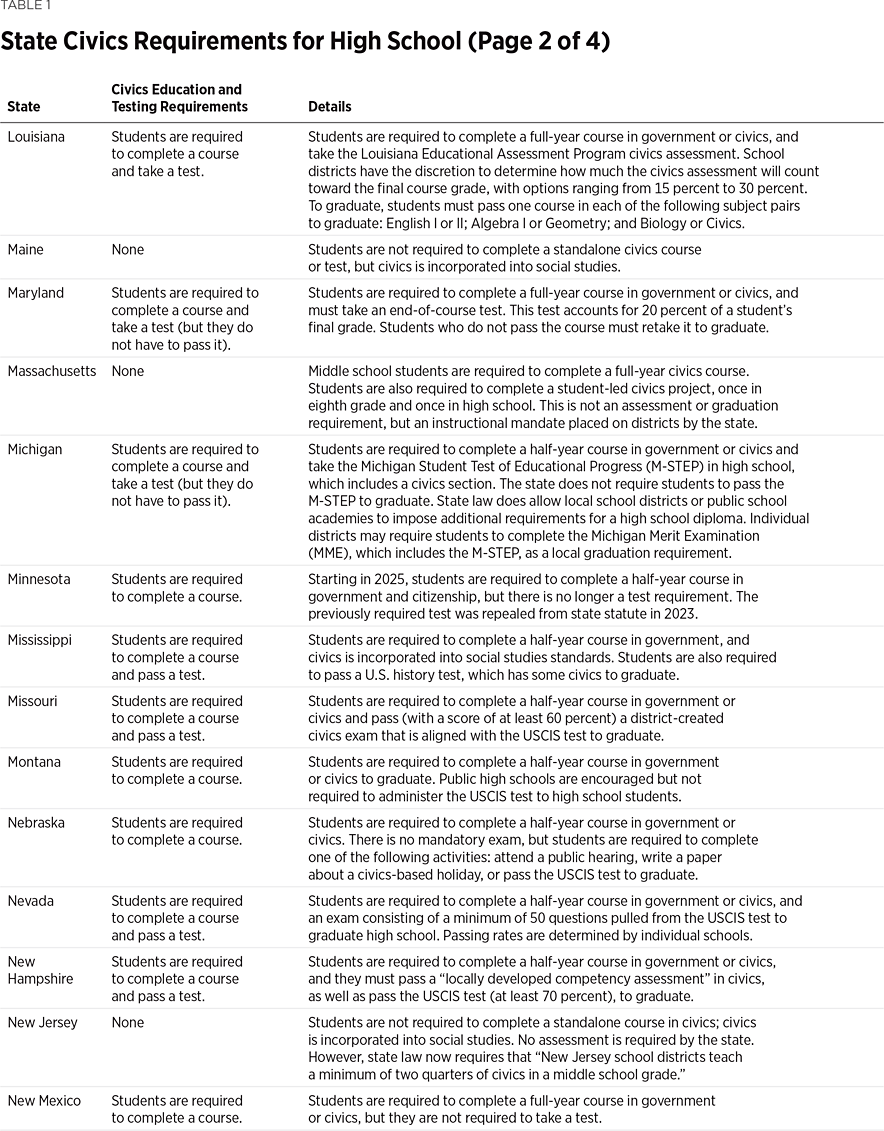
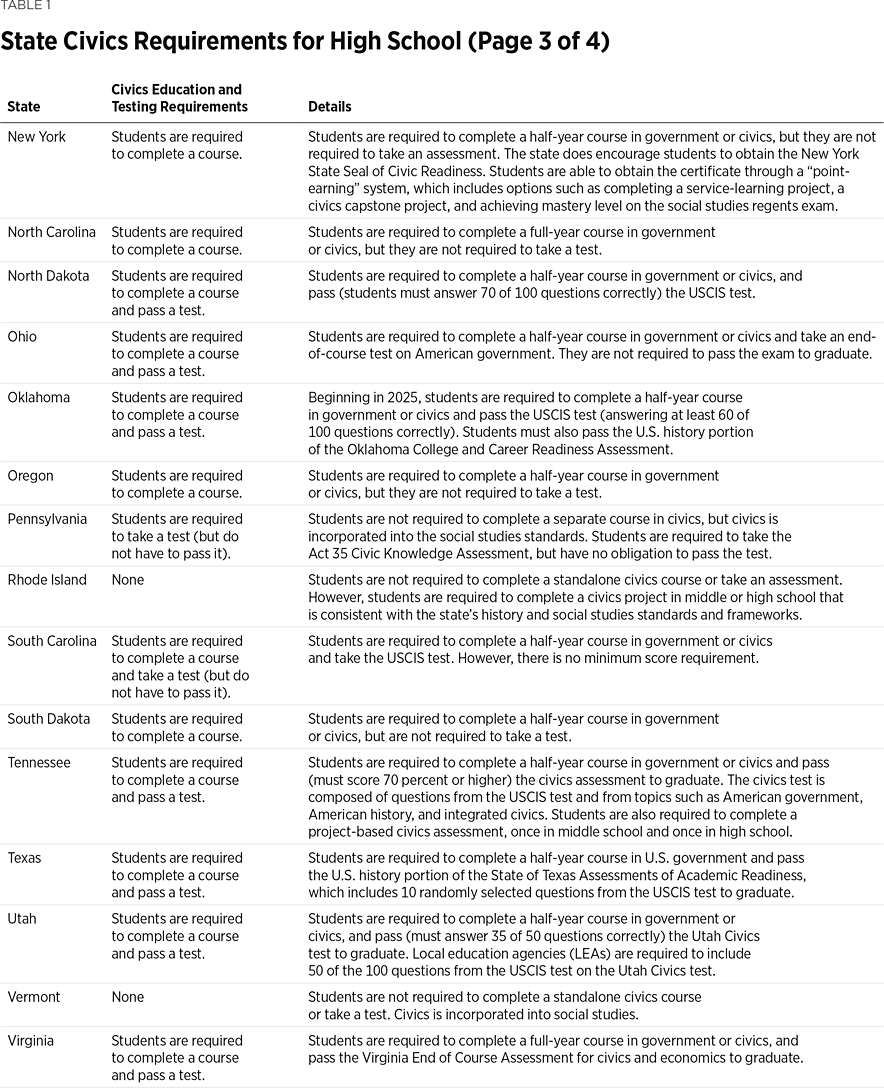
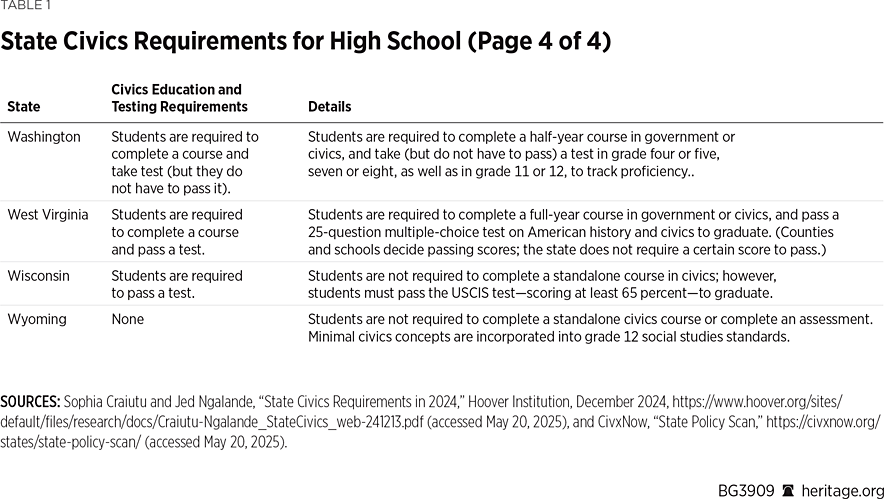
State Model Standards
Florida and Louisiana have recently strengthened their civic education requirements, setting a higher standard aimed at enhancing civic knowledge for both students and teachers. These reforms position both states as models for other states seeking to improve their own civic education.
Florida. In 2021, under the leadership of Governor Ron DeSantis (R), Florida established the Civic Literacy Excellence Initiative (CLEI), dedicating approximately $106 million in taxpayer resources to train teachers and develop civics content with the goal of helping students “to be great citizens.”REF The CLEI has three key components: (1) the formation and application of the Florida Civics Seal of Excellence—“a new professional licensure endorsement for educators in civics education”; (2) the development of a new career pathway program to pilot public service incubators that foster partnerships between secondary schools and government institutions; and (3) additional taxpayer spending to bolster Florida’s civics curriculum.REF These taxpayer resources also support expanded training, professional development, and classroom resources for teachers and administrators committed to enhancing civics education in their schools.
One high school social studies teacher praised the Civics Seal of Excellence course, stating it “should be a model for the entire nation” and that the course materials “are extremely valuable in making connections between historical context and modern-day applications.”REF As of 2025, more than 20,000 educators have completed the civics licensure training program, more than 48,000 have signed up to take the self-paced course, and thousands more teachers are on waiting lists.REF
As part of the CLEI, Florida also launched a “Portraits in Patriotism” oral history project, which equips K–12 educators with historical resources, lesson plans, and activities based on the oral histories of individuals who experienced the “human impact of war and dictatorship.”REF These individuals often fled countries with “governing philosophies that differ significantly from those of the United States,” such as socialism and military dictatorships.REF Additionally, the state introduced “Stories of Inspiration,” a new K–12 curriculum designed to “inspire future generations through motivating stories of American history that demonstrate important life skills and the principles of individual freedom that enabled persons to prosper even in the most difficult circumstances.”REF
Civics standards are integrated into every grade level in Florida’s K–12 system. From kindergarten through fifth grade, students are introduced to key themes, such as “Foundations of Government, Law, and the American Political System,” “Civic and Political Participation,” and “Structure and Functions of Government.”REF These themes are age-appropriate and thoughtfully designed—for example, first-graders are expected to “describe the characteristics of citizenship in the school community,” such as treating others with dignity and respecting others’ property and “recognize symbols and individuals that represent Florida and the United States.”REF
In grades six through eight, students must complete a one-semester civics education course, culminating in a standardized end-of-course exam that counts for 30 percent of the final grade. The course covers topics including the “roles and responsibilities of federal, state, and local governments; the structures and functions of the legislative, executive, and judicial branches of government; and the meaning and significance of historic documents, such as the Articles of Confederation, the Declaration of Independence, and the Constitution of the United States.”REF
At the high school level, students are required to complete a yearlong U.S. history course and a half-semester course in U.S. government to graduate. After completing the government course, students take the Florida Civic Literacy Examination (FCLE). Those who pass the FCLE are not required to take the postsecondary civics assessment also mandated by state law.REF
Louisiana. In 2022, Louisiana revised its social studies curriculum to raise the quality and deepen students’ civic understanding. State Superintendent of Education Cade Brumley emphasized that the updated standards aim to ensure that students recognize their responsibility to “protect, sustain, and improve our Constitutional Republic.”REF The new standards, known as the Freedom Framework, aim to “tell the story of American exceptionalism as well as our continuous journey towards becoming a more perfect union.”REF They were first implemented in classrooms during the 2023–2024 school year.
From kindergarten through third grade, students are introduced to the core disciplines of social studies: history, civics, economics, and geography. Each grade includes an age-appropriate introduction to civic principles. For example, kindergarten students learn about fairness, responsibility, respect, and hard work by taking care of personal belongings and respecting the property of others.REF In first grade, students explore the branches of Louisiana’s state government and the state’s unique role in the United States.
As students build foundational knowledge of their communities, parishes, state, and country, the curriculum expands in fourth grade to include the ancient and classical world. By sixth grade, students return to the study of American history, covering the nation’s Founding, the early republic, Reconstruction, and the industrial age through the modern era across grades six, seven, and eight.
In high school, students take a standalone civics course in addition to U.S. history (1776 to 2008), world history, and world geography. The civics course is designed to deepen students’ understanding of the origin, structure, and functions of government. It also provides “practical knowledge about how the American system of government functions on local, state, and national levels, as well as an understanding of the philosophical and intellectual underpinnings of our constitutional republic.”REF
All high school students are required to take the Louisiana Educational Assessment Program (LEAP) civics exam, based on the content from the required civics course. The first testing period began in the 2024–2025 school year. To graduate, students must pass one course in each of the following subject pairs: English I or II; Algebra I or Geometry; and Biology or Civics.REF
To support the implementation of these new standards, Louisiana has released new course frameworks. These resources offer educators “suggested pacing, framing, and supporting questions, and [access to] high-quality primary and secondary sources.”REF
Beginning in 2025, the state now offers the “Freedom Framework Diploma Endorsement”—awarded to students who achieve a score of “Mastery” or better on the LEAP exam.REF Students who earn the award will receive a special distinction at their graduation ceremony.REF
Policy Recommendations for Policymakers
In order to establish rigorous civics learning opportunities for K–12 students, state lawmakers should:
- Require high school students to earn passing scores on a civics assessment as a condition of graduation. Policymakers in some states, such as Connecticut, Indiana, and Ohio, require students to take a civics course or a civics test, or both, but do not require students to earn a passing score as a condition of graduation.
- Adopt standards that require students to either earn a passing grade in a civics class or earn a passing grade on a civics test that is at least as rigorous as the U.S. citizenship test to graduate high school. Students who fail the civics test should then be required to take, and pass, a civics course.
- Adopt training programs for civics instructors. State officials nationwide should adopt teacher training programs and model civics coursework similar to those in Florida and Louisiana. The coursework should teach students the differences between authoritarian governments and representative democracies and prepare teachers to discuss topics such as civil rights to explain why and how race-based policies conflict with America’s Founding ideals of a colorblind system of law and government.
In order to preserve state autonomy over K–12 civics instruction, federal policymakers should:
- Reject national standards for K–12 civics instruction. Federal law prohibits the U.S. Department of Education from establishing “grants, contracts, or other cooperative agreements” that “mandate, direct, or control a State, local educational agency, or school’s specific instructional content, academic standards and assessments, curricula, or program of instruction.”REF Federal policymakers should not create new academic standards for states nor compel states to adopt certain standards or content.
Conclusion
In a U.S. Chamber of Commerce survey of 2,000 voters conducted in 2024, one of three respondents did not know that the U.S. government has three branches, and more than half did not know how many members serve in the U.S. House of Representatives.REF These adults had not merely forgotten what they learned in high school—many never learned these basics to begin with. Some states do not have any civics education requirements, while others do not require students to earn passing scores on civics exams before graduating. Reliable comparisons of student performance on civics tests reveal mediocre results, and observers on both sides of the ideological divide recognize the problem.
State lawmakers should adopt more rigorous requirements for civics coursework, following the examples in Florida and Louisiana. Civics is an essential subject for K–12 students and should be part of the required coursework. Parents, teachers, and policymakers should model civic behavior in the way they lead their families, their classrooms, states, and their nation.
Madison Marino Doan is Policy Analyst in the Center for Education Policy at The Heritage Foundation at The Heritage Foundation. Jonathan Butcher is Will Skillman Senior Research Fellow in Education Policy in the Center for Education Policy.




